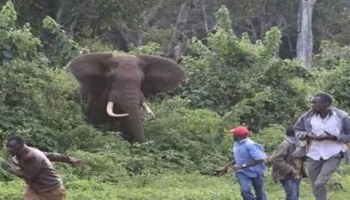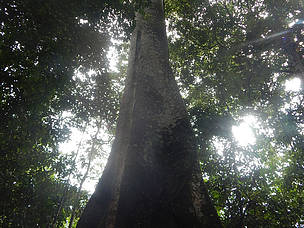Story, Louvier Kindo Tombe on special assignment in Campo
The chief of Bitande-Assock, a small village in Campo sub division of the south region of Cameroon had just returned from farm accompanied by his wife and children that Wednesday 15th of March 2023 when we arrived the palace. The traditional ruler of the village, His Majesty Ondo Pie Parfait, 3rd class chief only had time to remove his farm shoes before attending to us.
“We have been farming for animals in the past 15 years,” His Majesty Ondo Pie Parfait said.
“Today the same animals have decided to face us directly.”
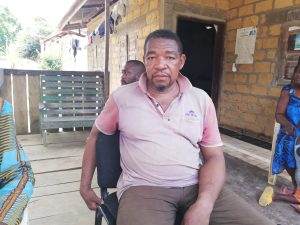
In all the eight villages around the Campo Ma’an national park in the south region, man-animal conflicts are taking a different proportion as the animals now visit homes in the localities.
“We were sleeping that night and suddenly heard noise of domestic animals running helter skelter, as I peeped, I saw 2 buffaloes in the palace yard,” say His Majesty Obate Akono Paul, traditional ruler of Nkoelon village in Campo sub division.
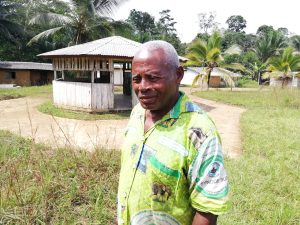
“Presently, everyone is in danger,” says His Majesty Ondo Pie Parfait.
Human-wildlife conflict is when encounters between humans and wildlife lead to negative results, such as loss of property, livelihoods, and even life.
“Last year, I lost my entire cassava farm of over two hectares to elephants,” says Ngono Ondo Marcelline, member of a women’s association in Nkoelon village known as ‘Afrisc-campo’.
The population in all the villages are afraid to move along within the community for reasons that they might come face to face with a wild animal.
“Whenever my children are in school, I can’t rest until they are back safely,” Bedibi Florence, a mother of 7 in Akak village told this reporter.
In Akak village like in other localities around the Campo Ma’an national park, the most common wildlifes attacking properties and population are elephants, buffaloes, monkeys, squirrels, just to name but these.
“Elephants are fond of attacking households mostly at nights and when it’s not yet harvest time,” says His Majesty Ondo Pie Parfait.
“The attacks have pushed us to abandone some of our cultural sites that have become resting places for the elephants.”
Roaming the wilderness
“Living together with animals is naturally challenging,” say Memvi Abessolo Charles, chief conservation officer of the Campo Ma’an national park. He added that “It is even more challenging when dealing with wild animals”.
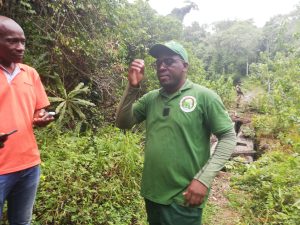
The different animals roaming around villages in Campo are from the Campo Ma’an national park.
The Government of Cameroon created Campo Ma’an national park in 1999 as compensation for the negative impacts on the environment and biodiversity of the Chad-Cameroon Oil Pipeline Project.
The 264 064 ha forest is home to about 500 plant species, 80 species of mammals including gorilla and elephants, 249 fishes, reptiles, 80 species of amphibians and over 300 species of birds.
However, the inhabitants living on the outskirts of the park are victims of animal attacks left with smaller space where to wander.
“The migration corridors of these animals have been destroyed by human activities,” says Ndongo Martin, notable of Nkoelon village.
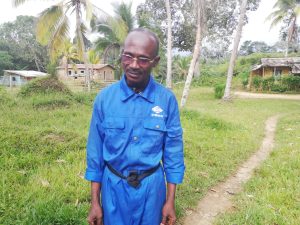
He was referring to the activities of an oil palm production agroindustry in the locality, Camvert. The company is exploiting a surface areas of close to 40.000 hectares. Besides the palm oil plantation project, Camvert is alleged to be carrying out illegal forest exploitation occupying the migration corridors of the animals which is pushing them out of the wild.
Besides Camvert, the activities of a wood exploitation agroindustry in the locality further frighten the wild animals out of the forest.
“We regret the absence of a systematic work to identify the migration corridors of elephants, it’s not when a project is installed that we will be seeking to identify it,” says Memvi Abessolo Charles.
In the south of Cameroon, the Campo Ma’an national park has been a safe haven for wildlife for years. Now dispersed into nature, the wild animals have no option than to feed on nearby farmlands owned by the locals.
“That is the main cause of human-wildlife conflict,” says Mr Memvi Abessolo.
According to him, human-wildlife conflicts are not only in areas with national parks.
“Recently in the Ntem Valley division of the south region which has no park, a troop of elephants was spotted there and casualties were recorded after,” Mr Memvi said.
Mitigating human-wildlife conflicts in Cameroon
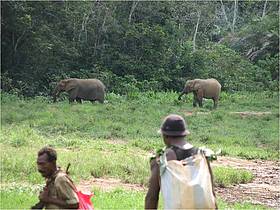
When Mr Ndongo Martin, notable of Nkoelon village returned home from abroad in the year 2000, the villagers were already grumbling about the constant attacks of wild animals from the Campo Ma’an national park. When he discovered the file of the agroindustry (Camvert), he became furious.
“I started crying after seeing my people cry immensely,” Mr Ndongo Martin said.
The notable has written a series of complaints to the conservation services of the park. More than 20 complaints from victims in eight villages have been recorded by the conservation services of Campo Ma’an national park.
“When you are into conservation, you are likely to encounter human-wildlife conflicts,” Mr. Memvi Abessolo said.
“Most complaints are directed to me because the population consider me as the proprietor of the wild animals of the Campo Ma’an national park.”
“We have a platform in Campo grouping all stakeholders in forest conservation and we meet constantly,” says Mr Bamock Francis Igor, divisional officer of Campo.

To him the complaints are real, and the government is permanently looking into each complain after verifications have been made on the field.
During a visit to the Nazareth village in Campo, the population revealed to us that at the level of the conservation services, nothing is done to see into their cries.
“I remember once I filed a complaint, and immediately I turned my back, the complaint was twisted and dumped into the trash,” says Chief of Nazareth village.
“It was unfortunate that the window of the conservation office was open, that is how I saw everything that happened as i stepped out of the office.”
Besides refusing to forward complaints from the villages to the powers that be in Cameroons political capital Yaounde, the villagers accuse officials of the conservation services of doing nothing to come to their rescue.
“When an animal is killed, the whole world storms the village, but when we are attacked, no one seems to care,” chief Ondo Pie Parfait told News Upfront.
His declaration was corroborated by the chief of Nkoelon who said “the animals are protected more than us humans”.
Way forward
All traditional methods to chase away the wildlife from the villages have failed.
“They used to allow us in the past to kill even one wild animal in a beat to chase away the rest, but that is not the case again today,” says His Majesty Mbili, chief of Nazareth village.
The forest management laws in Cameroon expose the indigenous communities to multiple conflicts between human-wildlife. An increase in wildlife crimes with no protection for indigenous people who denounce such crimes, insufficient legal procedure for reparation and compensation when protected wildlife destroys crops in indigenous communities, among others could be cited as examples.
The population in all the villages are unanimous that the government has abandoned them to fend for themselves.
“There is much to clarify with the laws governing conservation in Cameroon,” says Mr Memvi Abessolo.
The government since 2008 embarked on revising the first law in the country, but a draft revised document circulating on social media indicates that though much has been done, the aspect of human-wildlife management is widely ignored.
Some civil society organizations in Cameroon (more than 20) have formulated recommendations for a legal framework for wildlife management that better protects the rights and interests of indigenous people and local communities, by strengthening; human – wildlife conflict management; integration of local communities in the fight against poaching and wildlife crime; promote community-led conservation initiatives; promote community involvement in the creation and management of protected areas among others.
“Human-wildlife conflicts are considered as natural disasters, and in Cameroon it is not the ministry of Forestry and Wildlife in charge of national disasters but the Ministry of Territorial Administration,” says Mr Memvi Abessolo.
That is why it becomes challenging mitigating the situation. That is why the government has not been able to compensate victims financially since the situation escalated recently.
“We have not have a case of financial compensation for animal attacks, and it all depends on the law plus other observations,” Mr Memvi Abessolo said.
“The situation is really challenging but we are working out something.”
The challenging situation is pushing the victims to want to embrace inappropriate methods to seek justice.
“If the worst come to be the worst, we shall return to killing the animals because it is the best way to chase them away,” says chief Obate Akono Paul of Nkoelon.
The chief conservation officer of the Campo Ma’an national park, Mr Memvi Abessolo Charles, who is considered as the proprietor of all the wildlife in the park, is of the opinion that the population should understand the migration status of wild animals especially elephants. To him “whenever elephants discover a fruitful site, be it in a village, they will always return”, so the population should bear that in mind.
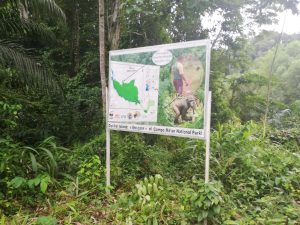
“If the government cannot resolve the conflict, they just have to employ and pay us monthly for us to farm for the animals,” chief Ondo Pie Parfait of Bitande-Assock declared to News Upfront, as a means of saying enough is enough.
“The government is not folding arms, we are planning a meeting to asses the level of human-wildlife conflicts in the village of Akak,” says D. O. Bamock Francis Igor.
The CSOs want government to encourage all consultations involving indigenous communities to involve the communities directly. To redefine community user rights to favour indigenous people and better protect wildlife from straying into villages. To redefine terms to provide access for indigenous communities to their sacred cultural and traditional sites/shrines found in protected areas. To decentralise the payment of wildlife royalties. To simplify and specify the compensation procedures for victims of human wildlife conflicts, and provide a lasting solution to the issue of wildlife attacking farmlands and households, among many others.
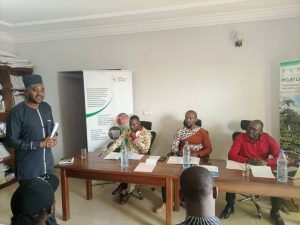
The proposals are destined to policy makers in the country. Green Development Advocate (GDA) and partners strongly believe that if these and many more are incorporated into the law under review, it will go a long way to mitigate human – wildlife conflicts.

